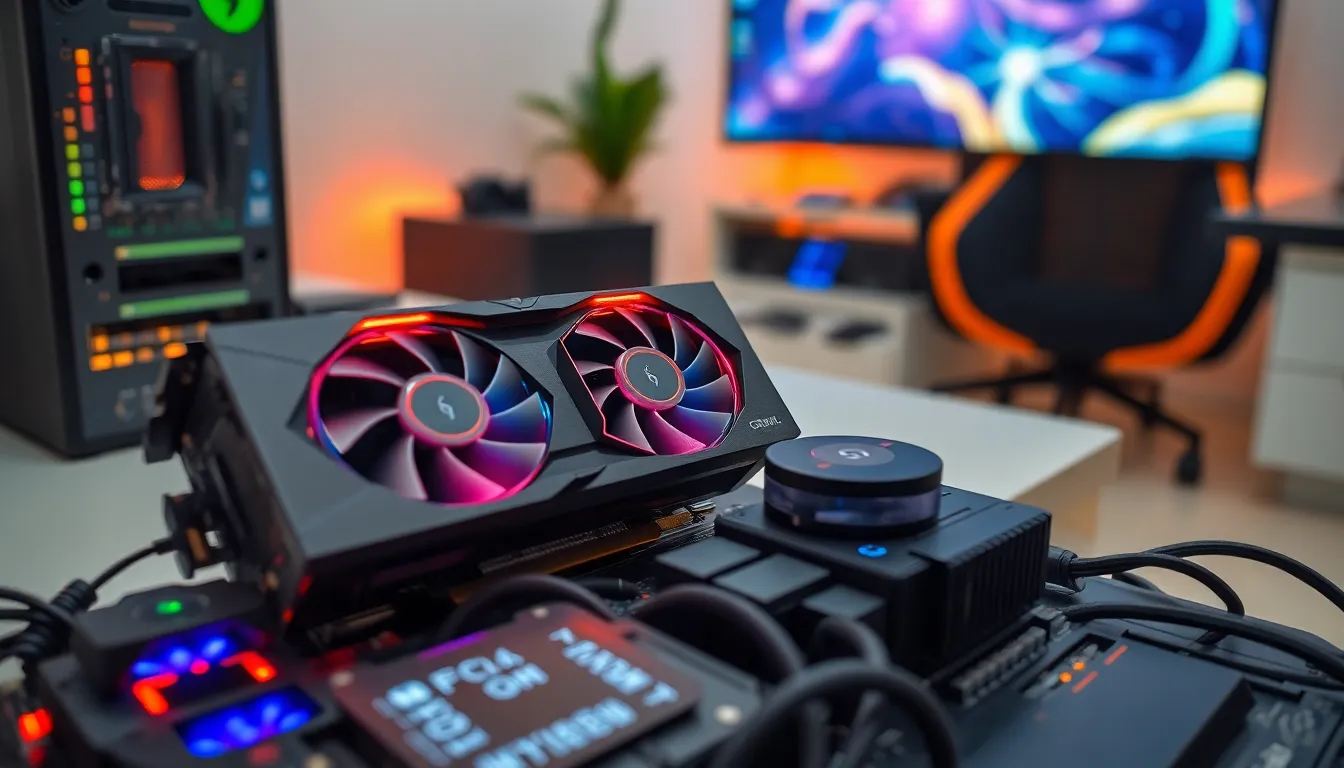In the world of gaming and video, frame rate consistency is the unsung hero that keeps everything running smoothly. Imagine trying to enjoy a thrilling race while your screen hiccups like a toddler learning to ride a bike. Not exactly the adrenaline rush you signed up for, right? This invisible force ensures that every frame flows seamlessly, making the difference between a mesmerizing experience and a frustrating one.
When frame rates fluctuate like a rollercoaster, gamers and viewers alike can feel the impact. Picture a dramatic showdown interrupted by sudden stutters—talk about a buzzkill! Understanding frame rate consistency isn’t just for tech geeks; it’s essential for anyone who craves smooth visuals and immersive storytelling. So buckle up as we dive into the nitty-gritty of frame rate consistency and why it deserves a spot in your tech toolkit.
Table of Contents
ToggleUnderstanding Frame Rate Consistency
Frame rate consistency refers to the stable delivery of frames during video playback or gaming sessions. This stability ensures that users experience smooth visuals without abrupt interruptions.
Definition of Frame Rate Consistency
Frame rate consistency involves maintaining a uniform frame rate throughout gaming or video playback. It focuses on preventing sudden drops or spikes in frame rates. Game developers strive for a consistent frame rate, typically at 60 frames per second or higher. Monitoring tools help assess performance, indicating variances. An ideal experience allows users to lose themselves in the action rather than be distracted by inconsistent performance.
Importance in Gaming and Video Playback
Frame rate consistency plays a vital role in enhancing user experience during gaming and video playback. Stutter-free visuals lead to immersive storytelling. Users become engaged when visuals appear seamless, creating a connection with the content. A lack of consistency often results in distraction, breaking the overall flow of the experience. Gamers can react quickly when frame rates remain stable, allowing for more precise control. In video playback, consistent frames ensure the narrative unfolds smoothly, maintaining viewer interest throughout.
Factors Affecting Frame Rate Consistency

Frame rate consistency relies on several critical factors that affect how smoothly visuals are rendered during gaming or video playback.
Hardware Limitations
Hardware limitations significantly impact frame rate consistency. Graphics cards play a vital role in processing visual data, and lower-end models may struggle to maintain stable performance. Processors also contribute; an underpowered CPU can bottleneck frame rendering, causing interruptions. Additionally, insufficient RAM affects performance, leading to slow load times and inconsistent frame rates. Upgrading components can yield noticeable improvements, often elevating the overall gaming experience.
Software Optimization
Software optimization is essential for achieving steady frame rates. Game developers often provide patches that enhance performance and stability, addressing known issues. Settings such as resolution and graphical fidelity also influence frame rates; reducing these can lead to smoother gameplay. Background applications consuming system resources can hinder performance. Users benefit from optimizing their settings, ensuring their software is updated, and closing unnecessary programs.
Network Conditions
Network conditions directly affect online gaming experiences and fluidity of video streaming. High latency or packet loss can disrupt real-time data delivery, leading to fluctuating frame rates. A stable and fast internet connection improves overall performance. Wired connections typically offer better reliability than Wi-Fi, reducing potential interruptions. Gamers often achieve smoother experiences by ensuring optimal network conditions.
Measuring Frame Rate Consistency
Measuring frame rate consistency provides insights into the performance of gaming and video experiences. Various tools and techniques exist to evaluate frame rates and identify fluctuations.
Tools and Techniques
MSI Afterburner serves as a popular tool for monitoring in-game frame rates. This software allows users to track frame variations in real-time, helping them assess performance. Fraps can also measure frame rates during video playback or gaming sessions. Capture cards, like Elgato, provide additional methods to record frame rates externally. Benchmarking software such as 3DMark evaluates hardware capabilities, revealing the potential for frame rate consistency. Utilization of these tools empowers users to make informed decisions regarding upgrades and optimizations.
Interpreting Results
Understanding frame rate data helps users gauge performance efficiency. Consistent frame rates depict smooth visuals, while significant fluctuations signal potential issues. A stable rate around 60 frames per second is ideal for gaming and video playback. If the average frame rate falls below this figure, it typically indicates hardware or software limitations. Frame rates experiencing high variability may lead to undesired effects like screen tearing or stuttering. Users benefit from analyzing the minimum and maximum frame rates, providing a clearer picture of consistency. With this knowledge, they can prioritize improvements in their setups and enhance overall experiences.
Solutions for Achieving Frame Rate Consistency
Several approaches exist to enhance frame rate consistency, ensuring a smoother gaming and video playback experience.
Upgrading Hardware
Upgrading hardware components significantly improves frame rate performance. Powerful graphics cards, like NVIDIA RTX or AMD Radeon models, enable higher frame rates and stability. Increasing RAM from 8GB to 16GB or more can eliminate bottlenecks during demanding tasks. A more robust processor, such as the Intel Core i7 or AMD Ryzen 7, can streamline performance and enhance gameplay efficiency. Enhanced cooling solutions also prevent throttling, supporting sustained performance during intense gaming sessions. Each hardware upgrade contributes to a more consistent frame rate, resulting in a seamless visual experience.
Adjusting Settings
Adjusting graphical settings could lead to notable improvements in frame rate consistency. Lowering resolution settings, utilizing lower texture details, or disabling anti-aliasing helps maintain a stable performance. Fine-tuning in-game features, such as shadow quality or view distance, enhances visual smoothness without sacrificing overall aesthetics. Games typically feature preset options, offering optimal settings based on specific hardware. Additionally, enabling V-Sync or Adaptive Sync can synchronize frame rates with monitor refresh rates, reducing screen tearing. Each adjustment plays a role in creating a more consistent visual output.
Utilizing Software Solutions
Utilizing software solutions optimizes performance and enhances frame rate consistency. Tools like MSI Afterburner or RivaTuner Statistics Server allow real-time monitoring of frame rates and system performance. Game optimization software often includes features to adjust settings automatically, ensuring the best performance based on hardware capabilities. Regularly updating drivers for graphics cards also ensures compatibility and stability, minimizing performance issues. Benchmarking applications like 3DMark help assess overall performance and identify potential upgrades. These software solutions collectively contribute to achieving and maintaining optimal frame rate stability.
Frame rate consistency is essential for anyone seeking an immersive gaming or video experience. By maintaining a stable frame rate users can enjoy smooth visuals that enhance engagement and storytelling. Understanding the factors that influence frame rate consistency empowers users to make informed decisions about hardware and software optimizations.
Investing in quality components and utilizing performance monitoring tools can significantly improve frame rates. Regular updates and adjustments can help prevent interruptions that detract from the overall experience. Ultimately achieving frame rate consistency transforms gaming and video playback into a seamless journey that captivates and entertains.





